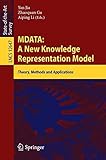MDATA: A New Knowledge Representation Model [electronic resource] : Theory, Methods and Applications /
Material type: TextSeries: Information Systems and Applications, incl. Internet/Web, and HCI ; 12647Publisher: Cham : Springer International Publishing : Imprint: Springer, 2021Edition: 1st ed. 2021Description: X, 255 p. 23 illus. online resourceContent type:
TextSeries: Information Systems and Applications, incl. Internet/Web, and HCI ; 12647Publisher: Cham : Springer International Publishing : Imprint: Springer, 2021Edition: 1st ed. 2021Description: X, 255 p. 23 illus. online resourceContent type: - text
- computer
- online resource
- 9783030715908
- Database management
- Artificial intelligence
- Information technology -- Management
- Application software
- Information storage and retrieval systems
- Database Management System
- Artificial Intelligence
- Computer Application in Administrative Data Processing
- Computer and Information Systems Applications
- Information Storage and Retrieval
- 005.7 23
- QA76.9.D3
Introduction to the MDATA Model -- The Framework of the MDATA Computing Model -- Spatiotemporal Data Cleaning and Knowledge Fusion -- Chinese Named Entity Recognition: Applications and Challenges -- Joint Extraction of Entities and Relations: An Advanced BERT-based Decomposition Method -- Entity Alignment: Optimization by Seed Selection -- Knowledge Extraction: Automatic Classification of Matching Rules -- Network Embedding Attack: An Euclidean Distance based Method -- Few-Shot Knowledge Reasoning: An Attention Mechanism based Method -- Applications of Knowledge Representation Learning -- Detection and Defense Methods of Cyber Attacks -- A Distributed Framework for APT Attack Analysis -- Social Unrest Events Prediction by Contextual Gated Graph Convolutional Networks -- Information Cascading in Social Networks.
Knowledge representation is an important task in understanding how humans think and learn. Although many representation models or cognitive models have been proposed, such as expert systems or knowledge graphs, they cannot represent procedural knowledge, i.e., dynamic knowledge, in an efficient way. This book introduces a new knowledge representation model called MDATA (Multi-dimensional Data Association and inTelligent Analysis). By modifying the representation of entities and relations in knowledge graphs, dynamic knowledge can be efficiently described with temporal and spatial characteristics. The MDATA model can be regarded as a high-level temporal and spatial knowledge graph model, which has strong capabilities for knowledge representation. This book introduces some key technologies in the MDATA model, such as entity recognition, relation extraction, entity alignment, and knowledge reasoning with spatiotemporal factors. The MDATA model can be applied in many critical applications and this book introduces some typical examples, such as network attack detection, social network analysis, and epidemic assessment. The MDATA model should be of interest to readers from many research fields such as database, cyberspace security, and social network, as the need for the knowledge representation arises naturally in many practical scenarios.


There are no comments on this title.